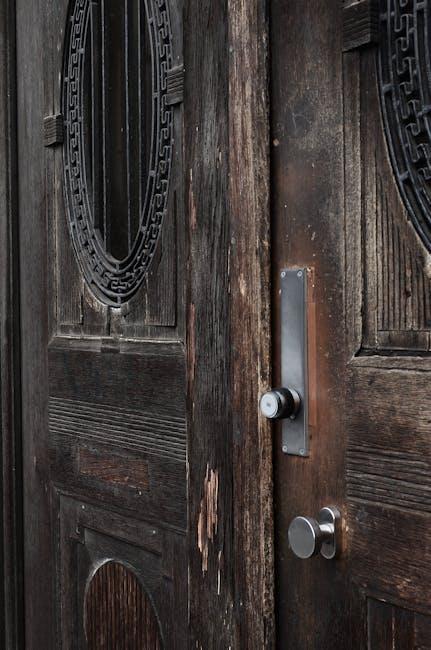As the icy grip of a Minnesota winter slowly loosens and the spring thaw begins to reshape the landscape, homeowners and businesses alike often encounter an unexpected challenge-lock problems. From frozen mechanisms to swollen wooden doors, the seasonal transition brings a host of common lock issues that can catch anyone off guard. In this article, we explore the typical lock troubles Minnesotans face during the spring thaw, offering insight into why they happen and practical tips to keep your locks functioning smoothly through the change of seasons.
Table of Contents
- Understanding the Impact of Spring Thaw on Lock Mechanisms
- Identifying Common Lock Problems Caused by Seasonal Moisture
- Preventative Measures to Protect Locks from Springtime Damage
- Step-by-Step Guide to Diagnosing and Fixing Frozen or Sticking Locks
- Choosing the Right Lubricants and Tools for Lock Maintenance in MN
- Q&A
- To Wrap It Up

Understanding the Impact of Spring Thaw on Lock Mechanisms
As the frozen ground begins to soften and moisture seeps into every crevice, lock mechanisms around Minnesota experience a unique set of challenges. The seasonal thaw introduces excess humidity and sediment into outdoor locks, which can lead to swelling, rust, and jamming. This often renders even the sturdiest locks vulnerable, especially those with intricate internal components exposed to the elements. Cold metal contracting during winter is replaced by expanding parts in the warmth, sometimes causing misalignment and difficulty in key entry or turn.
Homeowners and businesses should pay close attention to specific symptoms that indicate spring thaw-related wear. These include:
- Increased resistance when turning the key, signaling internal corrosion or debris buildup.
- Sticky or sluggish deadbolts, caused by moisture infiltration.
- Visible rust or discoloration on lock surfaces exposed to melted snow and rain.
Addressing these issues early ensures longevity and functionality. The following table summarizes common lock problems and their probable causes linked to thaw conditions:
| Lock Problem | Cause | Recommended Action |
|---|---|---|
| Key Won’t Turn | Rust buildup inside cylinder | Apply lubricant & clean lock |
| Lock Sticks | Moisture causing swelling | Dry lock & inspect weather seals |
| Corroded Exterior | Exposure to runoff water | Replace or protect with plating |

Identifying Common Lock Problems Caused by Seasonal Moisture
As the spring thaw sweeps across Minnesota, the shift in moisture levels can wreak havoc on the functionality of door locks. One of the most prevalent issues during this season is swelling caused by trapped moisture inside wooden doors or metal components. When moisture infiltrates these materials, it can cause the lock mechanism to stick or become misaligned, making it increasingly difficult to turn the key or engage the deadbolt smoothly. Additionally, condensation buildup often leads to rust developing on metal locks, further impeding the smooth operation of locks and increasing the chances of jamming or complete lock failure.
Understanding the symptoms of moisture-related lock issues is key to timely maintenance and prevention. Here are some warning signs to watch for:
- Stiffness when turning the key or thumbturn
- Unusual resistance or grinding sounds
- Visible rust or corrosion on lock surfaces
- Difficulty locking or unlocking even when the key fits
| Problem | Effect of Moisture | Recommended Action |
|---|---|---|
| Swollen door frame | Lock misalignment | Trim or sand door edges |
| Rust on lock cylinder | Key jamming | Apply lubricant, replace if necessary |
| Frozen moisture inside lock | Lock not turning | Warm lock gently, use de-icer |

Preventative Measures to Protect Locks from Springtime Damage
Spring thaw introduces moisture and fluctuating temperatures that challenge the integrity of your locks. To minimize damage, apply a high-quality lubricant, such as graphite powder or a silicone-based spray, which helps reduce friction and prevents rust buildup. Regularly cleansing lock exteriors with mild soap and water also dispels accumulated dirt and grit, ensuring smooth operation. For added protection, covering outdoor locks with waterproof caps or shields during heavy rainfall or melting snow can reduce moisture exposure significantly.
Routine inspection during spring is key-look for signs of wear like loose screws, corrosion, or sticking mechanisms. Implementing these quick fixes can prevent costly repairs down the line. Below is a quick checklist to keep your locks spring-ready:
- Lubricate keyways and bolt mechanisms monthly
- Clean lock surfaces to remove debris and moisture
- Install protective covers for external locks
- Check and tighten all fasteners
- Replace weather seals around door frames
| Preventative Step | Recommended Product | Frequency |
|---|---|---|
| Lubrication | Graphite Powder | Monthly |
| Cleaning | Mild Soap & Water | Weekly |
| Protection | Waterproof Covers | During Rain/Thaw |
| Inspection | Visual & Manual Check | Biweekly |

Step-by-Step Guide to Diagnosing and Fixing Frozen or Sticking Locks
Begin by carefully inspecting the lock for any visible signs of moisture or debris that might be causing it to freeze or stick. Use a flashlight to check inside the keyhole and along the bolt mechanism. If frost is present, gently apply a hairdryer or a portable heat source at a safe distance to thaw the lock evenly. Avoid using excessive force on the key, as this can damage the internal pins or tumblers. Lubrication is your next step: employ a graphite-based or silicone spray lubricant specifically designed for locks, as these repel moisture and prevent rust without attracting dirt. Spray sparingly into the keyhole, then insert and turn the key several times to distribute the lubricant evenly.
- Wipe off excess lubricant to prevent grime buildup
- Consider applying a waterproof cover to the lock during heavy spring rains
- Test the lock multiple times to ensure smooth operation before sealing
If the lock continues to stick despite these efforts, it may require disassembly for a deeper clean. Remove the lock mechanism carefully, clean all internal components with isopropyl alcohol to remove dirt and corrosion, and re-lubricate before reassembling. For electronic or smart locks facing freezing issues, consult the manufacturer’s troubleshooting guide, as the internal circuitry may need special attention or firmware updates. Remember, routine maintenance throughout the spring thaw season can extend the life of your locks and keep your home secure.

Choosing the Right Lubricants and Tools for Lock Maintenance in MN
When preparing for the challenges that come with the spring thaw in Minnesota, selecting the appropriate lubricants is crucial for ensuring smooth lock operation. Graphite powder remains a top choice because it doesn’t attract dirt or debris, which can otherwise exacerbate wear inside the lock mechanism. WD-40, while popular for general cleaning, should be used sparingly and never as a permanent lubricant since it can leave behind a residue that gums up over time. Always opt for products labeled specifically for locks, such as silicone-based lubricants, which provide lasting protection against moisture and corrosion-common adversaries in MN’s thawing months.
Equally important is having the right tools on hand. A compact lock pick set can be invaluable for minor jams, though caution and proper knowledge are essential to avoid damage. A clean, soft-bristle brush and microfiber cloth will help remove accumulated grit before lubrication, preventing abrasive particles from causing further lock deterioration. For homeowners and locksmiths alike, keeping a simple toolkit ready with these essentials can turn a frustrating lock freeze into a quick fix.
| Lubricant Type | Best For | Notes |
|---|---|---|
| Graphite Powder | Dry lubrication | Non-greasy, dust-resistant |
| Silicone Spray | Weatherproof protection | Water-resistant, non-corrosive |
| WD-40 | Short-term cleaning | Use sparingly, not a lubricant |
Q&A
Q&A: Common Lock Issues During Spring Thaw in Minnesota
Q1: Why do lock problems tend to spike during the spring thaw in Minnesota?
A1: As winter transitions into spring, fluctuating temperatures and melting snow introduce moisture and debris into lock mechanisms. This combination often leads to rust, swelling, or freezing of lock components, causing common malfunctions.
Q2: What are the most common lock issues homeowners face during the spring thaw?
A2: Common issues include frozen locks that won’t turn, swollen wooden door frames causing misalignment, rusted internal parts creating stiffness, and debris buildup inside keyholes hindering smooth operation.
Q3: How does the moisture from melting snow affect locks?
A3: Melting snow infiltrates locks, especially if their weatherproofing has deteriorated. This moisture can cause metal parts to corrode or freeze again overnight, leading to jammed or stiff locks that resist turning keys.
Q4: Can dirt and debris from thawing ground impact lock functionality?
A4: Absolutely. Spring thaw often stirs up dirt, sand, and small grit particles, which can get lodged inside lock cylinders. Accumulated debris makes it harder for key pins to move freely, resulting in sticking or fully jammed locks.
Q5: What precautions can Minnesotans take to prevent lock issues during the spring thaw?
A5: Regular maintenance is key. Applying graphite or silicone-based lubricant to locks helps repel moisture and prevent rust. Checking door alignment and sealing gaps can reduce moisture entry. Also, gently cleaning keyholes to remove debris before problems arise is advised.
Q6: How should one safely thaw a frozen lock?
A6: Avoid using excessive force that might break keys or damage locks. Instead, use a lock de-icer spray or warm (not boiling) water applied carefully with a cloth to gradually warm and loosen the frozen components.
Q7: When should a homeowner call a locksmith during spring thaw lock issues?
A7: If lubricating and warming the lock don’t work, keys are difficult to insert or turn, or the lock shows visible damage or rust, it’s wise to contact a professional locksmith promptly. Early intervention prevents costly replacements or lockouts.
Q8: Are there specific locks better suited for Minnesota’s spring climate?
A8: Weather-resistant locks designed with corrosion-resistant materials and sealed mechanisms perform better in harsh, fluctuating climates. Investing in such locks can reduce spring thaw issues and extend lock longevity.
Q9: Can lock problems during spring thaw affect home security?
A9: Definitely. Malfunctioning locks can leave doors improperly secured, increasing vulnerability to break-ins. Promptly addressing lock issues ensures doors latch properly and maintain the security integrity of the home.
Q10: What’s the best mindset Minnesotans should adopt toward spring thaw lock care?
A10: Consider locks part of your seasonal maintenance routine. Just as you prepare your home for fluctuating weather, giving attention and care to your locks during spring thaw will ensure they remain dependable year-round.
To Wrap It Up
As the frozen landscape of Minnesota slowly melts away, bringing the promise of spring, it also ushers in a unique set of challenges for homeowners-especially when it comes to locks. From swollen wooden doors to moisture-induced rust, these common lock issues are a reminder that Mother Nature’s thawing touch can affect more than just the scenery. By understanding these seasonal quirks and taking simple preventive steps, you can keep your locks turning smoothly and your home secure throughout the changing seasons. So, as you enjoy the fresh blooms and warmer days, don’t forget to give a little attention to your locks-they’ll thank you with reliable protection all year long.





